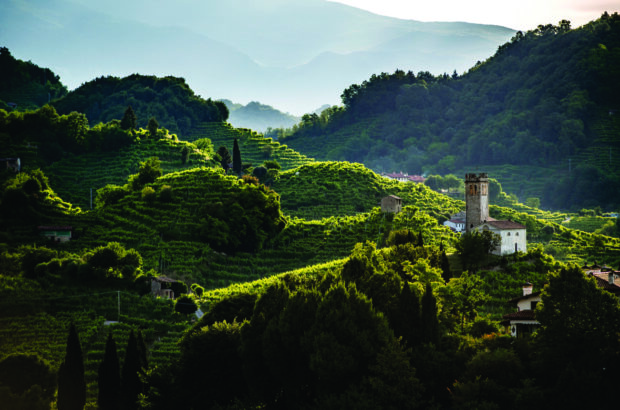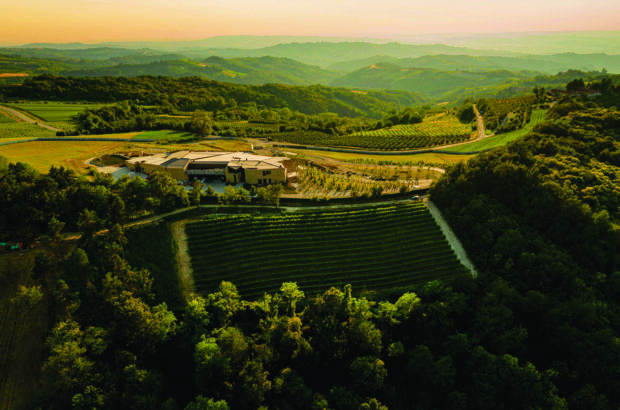Anyone who has spent time in the Rioja region will be familiar with its main speciality: grilled lamb cooked over an open fire made from vine cuttings. It’s extraordinarily good – the meat is young and tender and harmonises perfectly with the local Tempranillo-based wines.
But although the region’s food is traditionally quite simple, rustic and based on a wealth of good local ingredients, there’s more to it than meat (though the suckling pig is delicious and there is always jamón too). Fish from the coast finds its way into the markets and restaurants, particularly hake, tuna and salt cod – the basis for another trademark speciality, bacalao a la Riojana.
Vegetables and pulses are abundant, and in many cases preserved so you can eat them year-round. Artichokes, asparagus and cardoons are incorporated in a wonderful spring vegetable stew called menestra, often offered as a vegetarian option, although it generally includes ham – which the locals seem to reckon doesn’t count.
There is also a multitude of dried beans that form the basis of the region’s hearty stews or can be served as simple sides with fish such as hake (see recipe below). Although pork fat was traditionally the cooking medium (according to Claudia Roden’s The Food of Spain), olive oil is ubiquitous these days.
The cuisine is also spicier than you might guess from the simply seasoned lamb. Many dishes are flavoured with paprika (pimentón) which comes in both sweet (dulce) and hot (piccante) versions and finds its way into the tasty local chorizo sausages. Riojanos also love to use garlic – there’s scarcely a recipe without it alongside the omnipresent tomato.
Tapas culture is strong here, and most bars offer tapas, including mushrooms (my favourite) – the only dish they serve in Bar Soriano in Logroño (see recipe below).
Sheep’s cheese is the most widely available cheese, though there is a local goat’s cheese called Camerano that’s well worth looking out for if you are visiting the region. But the great thing is that you can easily eat like a Riojano at home. Give it a try!
Hake with garlic chips and white beans

Credit: Louise Haywood-Schiefer
Hake is Spain’s absolutely favourite fish, made extra delicious with a scattering of crisp garlic chips and creamy white beans. Perfect with an oaked white Rioja.
Serves 2
Preparation time 5 minutes
Cooking time 10 minutes
Ingredients
- 3tbsp + 1tsp olive oil
- 5 garlic cloves, peeled and finely sliced
- 50ml oaked white Rioja
- 50ml fish or vegetable stock
- 1 handful flat-leaf parsley leaves, chopped
- good pinch dried chilli flakes
- 2 x 175g hake fillets
- sea salt and freshly ground black pepper
- 1⁄2 large jar (600g) Spanish white haricot beans
- 1 sprig thyme
Method
1. Drain the beans and put them in a saucepan with the thyme and 50ml of water.
2. Heat through, stirring until the water is mostly evaporated and the beans are creamy. Keep warm while you cook the fish.
3. Warm 3 tbsp of olive oil in a small frying pan over a moderate heat. Add the sliced garlic cloves and once they begin to colour turn the heat down and cook until golden and crispy, taking care not to burn them. Remove the garlic ‘chips’ from the pan with a slotted spoon and keep warm.
4. Pour the wine into the pan, let it bubble up and then add the stock, parsley, a pinch of sea salt and chilli flakes. Simmer for a couple of minutes then pour into a small bowl.
5. Wipe the pan with a paper towel and add 1 tsp of olive oil. Season the hake fillets lightly with salt and pepper and place each fillet skin side down in the pan. Fry for 3-4 minutes until the skin is crisp and the fish just over half cooked. Turn the fillets and cook on the other side for about 30 seconds to one minute.
6. Place the hake fillets on warm plates. Warm through the sauce and pour it over the hake then scatter with the fried garlic chips. Serve with the white beans.
The wines to pair
Hacienda López de Haro, Blanco 2021
La Rioja Alta, The Society’s Exhibition Reserva, Reserva 2018
White asparagus with tuna and mayonnaise

Credit: Louise Haywood-Schiefer
More of an assembly job than a recipe, making the best use of Spain’s fantastic canned produce.
Serves 4
Preparation time 10 minutes
Ingredients
- 1 large tin or 2 x 500g jars white asparagus
- 112g tin high-quality tuna (such as Ortiz)
- 100g homemade or shop-bought mayonnaise
- freshly grated lemon rind
- black pepper
Method
1. Arrange the asparagus on four plates. Roughly break up the tuna and spoon over the spears. Put the mayonnaise in a bowl and add enough of the liquid from the asparagus tin to loosen it slightly.
2. Season with black pepper (you shouldn’t need salt) and spoon over the asparagus and tuna. Finish with a little freshly grated lemon rind.
The wines to pair
Mushroom tapas, Logroño-style

Credit: Louise Haywood-Schiefer
I had a dish like this at Bar Soriano in Logroño’s Calle Laurel, which offers only garlicky mushrooms to eat. You can serve it on a fresh or lightly toasted baguette – I marginally prefer the crunch of the latter. Either way, it sets off a good red Rioja perfectly.
Serves 4
Preparation time 5 minutes
Cooking time 10 minutes
Ingredients
- 3 tbsp extra-virgin olive oil
- 225g small chestnut or button mushrooms, wiped, trimmed and thinly sliced
- 2 large garlic cloves, finely chopped
- 20g butter
- 2 heaped tbsp finely chopped parsley
- salt, black pepper and a good pinch of sweet paprika
- 12 thin slices of baguette (about 1.5cm thick)
Method
1. Heat a medium-sized frying pan, add the oil then tip in the mushrooms. Cook without stirring for 2-3 minutes then flip the mushrooms and continue cooking for a couple of minutes.
2. Add the chopped garlic and continue to cook for another 4-5 minutes, until any liquid is absorbed. Add the butter and parsley, heat through and season with salt, pepper and a good pinch of sweet paprika.
3. Take off the heat and set aside while you lightly toast the baguette slices. Pile the mushrooms on top of them and serve immediately.
The wines to pair
Muga, Prado Enea Gran Reserva 2015
Bodegas Palacio, Glorioso Reserva 2017
Smoky lamb chops with patatas bravas

Credit: Louise Haywood-Schiefer
Tapas fans will know that bravas is the name of a spicy sauce, spiked with paprika and commonly served over fried potatoes. My version is based on the one from my local tapas bar, Bar 44 in Bristol. It makes enough for twice this quantity of potatoes but it’s useful to keep in the fridge or freezer. I also like roasting the potatoes rather than frying them, which cuts down on last-minute work and frying smells (fine in a restaurant, less good in a home kitchen).
Serves 4
Preparation time 30 mins
Cooking time 2 hours
Ingredients
- 2-3 lamb cutlets per person
- smoked salt (I like the version from the Cornish Sea Salt Co)
- 800g potatoes (King Edward or similar)
- 1 tbsp plain flour
- 1⁄2 tsp salt
- 4 tbsp olive oil
For the bravas sauce
- 3 tbsp olive oil
- 2 large garlic cloves, peeled and finely sliced
- 1 large, fresh red chilli, finely sliced
- 1 fresh bay leaf (optional)
- 1 sprig thyme (leaves stripped)
- 1 tsp hot paprika
- 1 tsp sweet paprika
- 1 large Spanish onion, chopped
- 75ml oaked white Rioja
- 1 small jar roasted piquillo peppers, drained (about 175g)
- 400g tin chopped tomatoes
- 2-3 tbsp chopped flat leaf parsley
- salt and black pepper
Method
1. Take the cutlets out of the fridge and leave at room temperature while you prepare the patatas bravas.
2. First make the sauce. Warm the olive oil over a moderate heat and add the sliced garlic, stirring until it begins to turn golden. Add the sliced chilli, cook for one minute, then stir in the bay leaf, thyme and paprika. Add the onion, cover the pan and leave on a low heat for about 20 minutes until the onion is completely soft. Turn up the heat, add the Rioja, bubble up to reduce, then add the piquillo peppers and chopped tomatoes. Turn down the heat and leave to simmer, uncovered, for about 30 minutes.
3. Take off the heat, cool for a couple of minutes, remove the bay leaf, then blitz the sauce in a blender until smooth. Return half the sauce to the pan and set aside until ready to reheat. (Put the rest in a container and refrigerate or freeze).
4. Heat the oven to 200°C/400°F/gas 6.
5. Peel the potatoes and cut into smallish chunks. Put in a saucepan of cold water, bring to the boil and simmer for 5 or 6 minutes. Drain and shake the potatoes in a colander, sift over the flour and salt, then shake again. Put a roasting tin in the oven with 4 tbsp olive oil, heat through for a few minutes then tip in the potatoes. Roast for about 50-60 minutes, turning them from time to time until well browned and crisp.
6. Just before the potatoes are done, fire up the barbecue or heat a ridged grill pan. Rub a little olive oil into the surface of each lamb cutlet and sprinkle with smoked salt. Place the cutlets on the grill and leave for 2-4 minutes depending how thick they are. Turn them over and grill the other side for a minute or two. Remove from the grill and leave on a platter to rest.
7. Transfer the potatoes to a serving plate. Heat through the bravas sauce, pour over the potatoes and sprinkle with chopped parsley. Serve with the cutlets, alongside some allioli (garlic mayonnaise) and a simple green salad.
The wines to pair
Sierra Cantabria, Reserva 2015
Photography by Louise Haywood-Schiefer, food styling by Nikki Morgan












